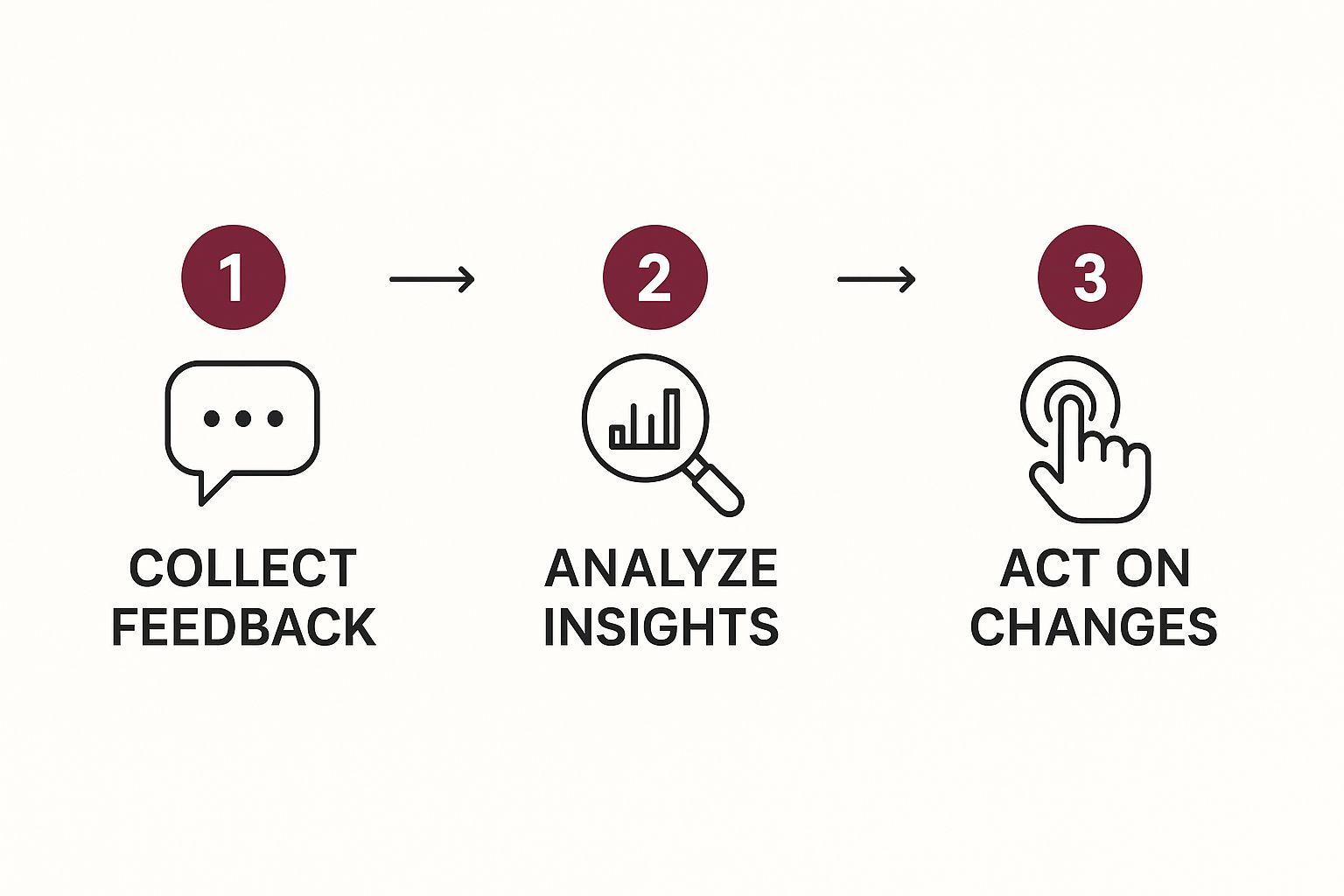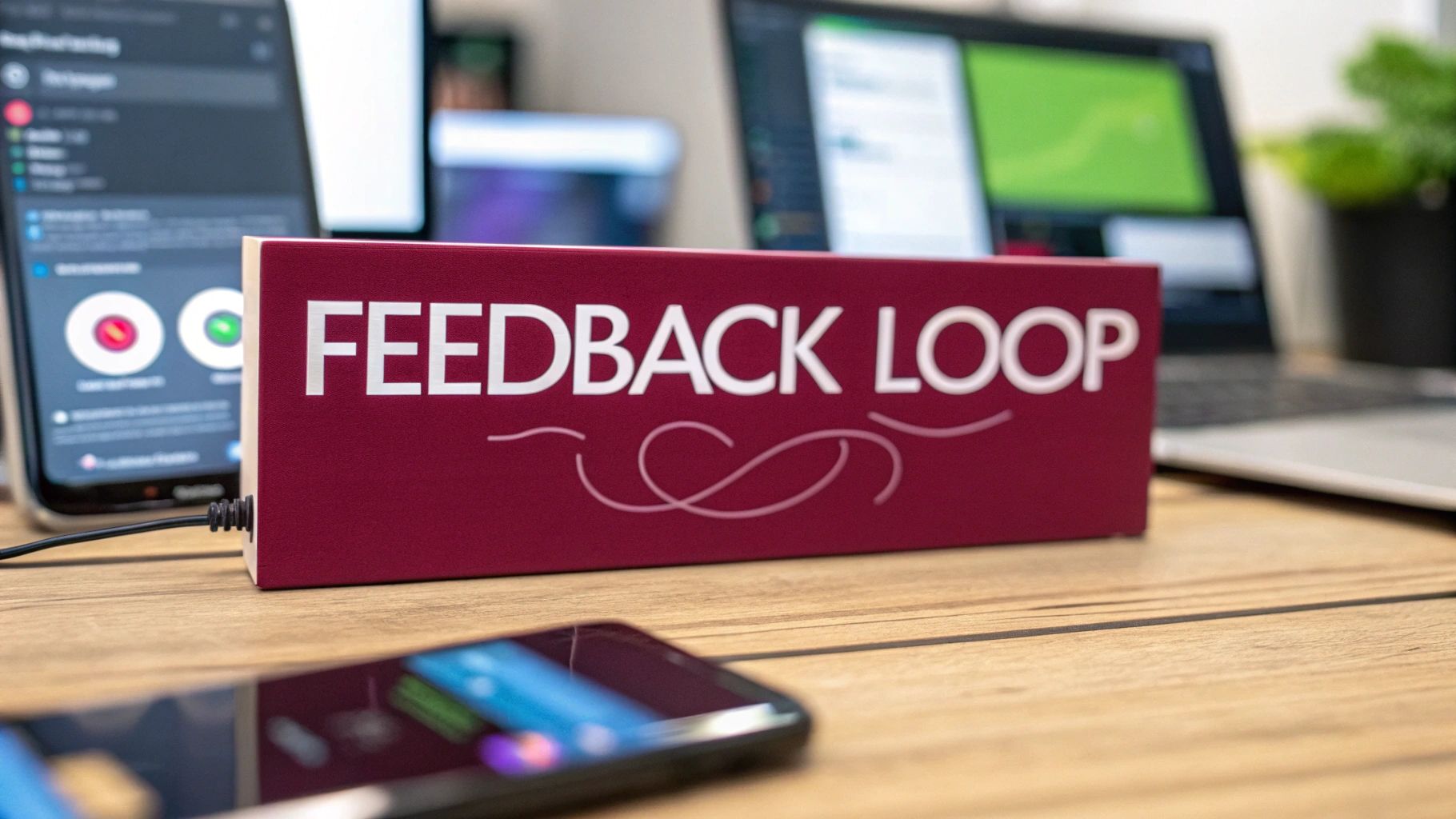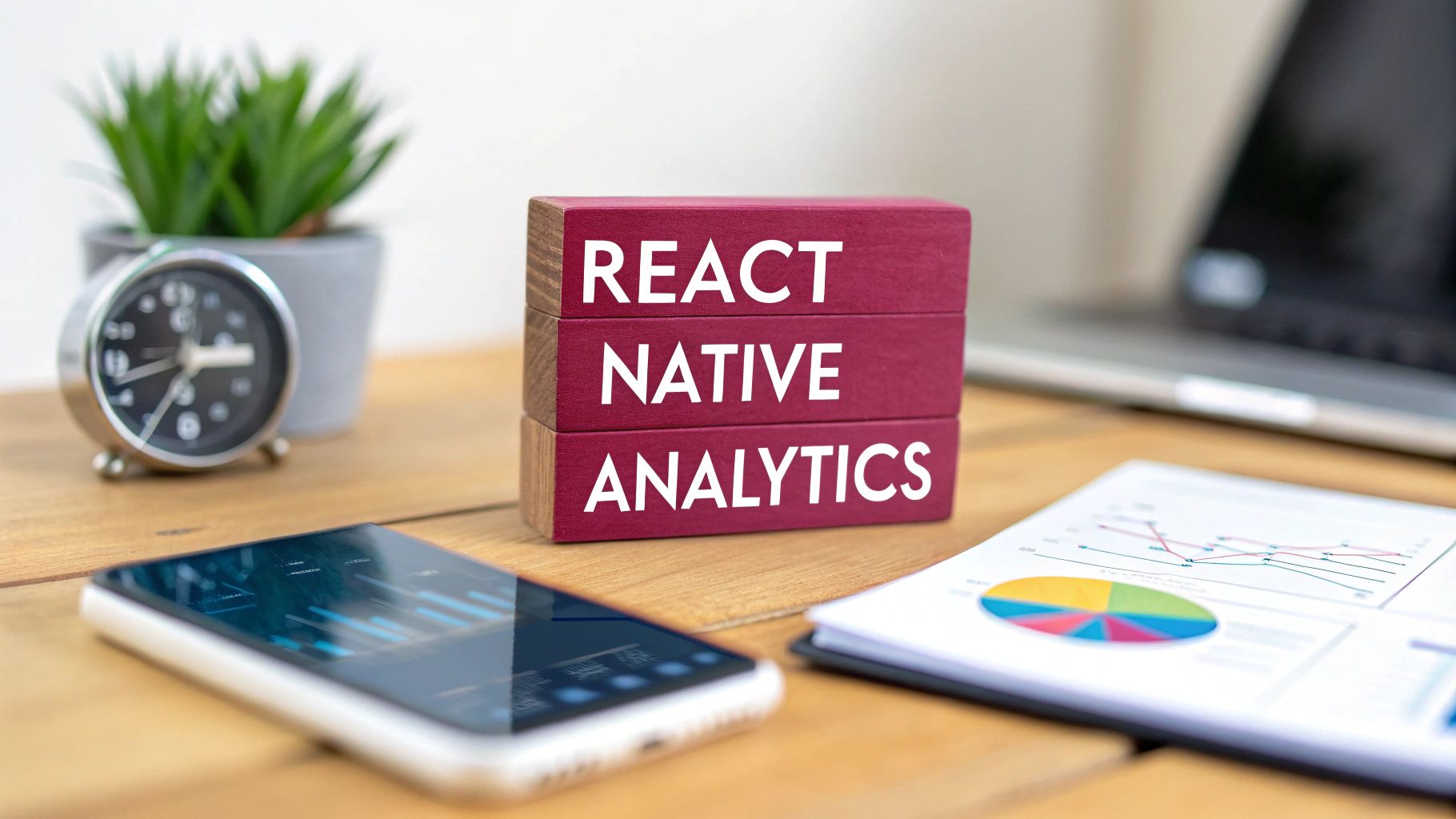At its core, a continuous feedback loop is a living, breathing process. Development teams constantly gather user data, dig into it for real insights, and then use those findings to make the app better. Think of it less like a rigid blueprint and more like a real-time conversation with your users, guiding your app toward what people actually want.
Why a Continuous Feedback Loop Is Your Secret Weapon
In today’s fast-paced app world, you can’t afford to guess. The old way of working—spending months building features in a silo, only to launch and hope for the best—is a recipe for disaster. It’s slow, incredibly risky, and almost always ends in expensive course corrections. This is precisely why a continuous feedback loop isn’t just a nice-to-have; it’s an absolute necessity.
Instead of a one-way street from idea to release, this approach creates a powerful, ongoing cycle that keeps your team perfectly in sync with real user behavior. It’s a foundational concept in modern development, and we explore how it fits into the bigger picture in our guide on agile mobile app development. By working in short, iterative bursts, you can test ideas quickly, learn from them, and change direction without burning through your budget.
Let’s look at how this changes the game.
Traditional vs Continuous Feedback Loop Models
The table below breaks down the fundamental differences between the outdated, linear development cycle and a modern, continuous approach. It’s a shift from a “launch and pray” mentality to a “build, measure, learn” rhythm.
| Aspect | Traditional Model | Continuous Feedback Loop |
|---|---|---|
| Development Cycle | Linear, sequential phases (e.g., Waterfall) | Iterative and cyclical (e.g., Agile, DevOps) |
| Feedback Timing | Delayed until the very end of the project | Constant, collected at every stage |
| Decision-Making | Based on initial assumptions and internal opinions | Driven by real-time user data and analytics |
| Risk Level | High; major issues discovered late in the process | Low; problems identified and fixed early |
| Pace of Improvement | Slow; updates are large, infrequent, and disruptive | Rapid; small, frequent updates delivered seamlessly |
The takeaway is clear: one model is built for a world that no longer exists, while the other is designed for the dynamic, user-centric reality of modern app development.
Shifting From Guesswork to Data-Driven Decisions
This isn’t just some developer trend; it’s a powerful business strategy. Its value is recognized everywhere. Back in 2019, nearly a third of American companies had already swapped out old-school annual reviews for continuous feedback systems. The results speak for themselves—Adobe, for instance, saw a 30% spike in engagement after they made the switch.
For your mobile app, this translates to tangible benefits:
- You stop wasting time and money. Instead of building features based on a hunch, you’re responding directly to what your analytics and user feedback are telling you.
- User satisfaction skyrockets. When you quickly squash bugs and roll out improvements people actually asked for, you create a much better experience. That means higher App Store ratings and users who stick around.
- Your team gets on the same page. Everyone, from the newest developer to the lead product manager, is focused on a single, clear goal defined by real users—not just internal debates.
The Role of Continuous Integration
So, how do you make this loop spin faster and more reliably? The answer is Continuous Integration (CI).
CI is the practice where developers regularly merge their code changes into a central repository. Every time they do, automated builds and tests kick off immediately. This automation is the engine that drives a fast, effective feedback loop. It gives developers instant feedback on code quality, making it possible to build, test, and learn at a speed that would be impossible manually. To dig deeper, check out these advantages of continuous integration, including faster feedback loops. In short, CI is what powers the “build” stage of your feedback cycle, ensuring it’s fast, consistent, and dependable.
Understanding the 4 Stages of Your Feedback Loop
To really get a handle on the continuous feedback loop, don’t think of it as a single task. It’s more like a constantly spinning wheel with four key stages. This cycle moves development away from a straight line with a finish line and turns it into a process of perpetual improvement. Each stage flows right into the next, making sure your app gets better based on what users are actually doing, not just on what your team thinks they want.
The four stages are Plan, Build, Measure, and Learn. This framework takes the guesswork out of your development, putting data and user behavior at the center of every decision. Let’s walk through how this plays out, specifically for a React Native team.
The Plan Stage: Where It All Starts with a Hypothesis
Every good cycle kicks off with a clear hypothesis. This isn’t just a shot in the dark; it’s an educated guess based on real data you already have, feedback from users, or what you’re seeing in the market. The idea is to pinpoint a specific change that you believe will make the app genuinely better for your users.
For instance, maybe your analytics show that a lot of people are abandoning the app during onboarding. Your hypothesis could be: “By cutting our sign-up form down from five fields to just three, we can boost our user completion rate by 15%.” That statement is precise, it’s measurable, and it gives the team a concrete goal for this cycle.
The Build Stage: Bringing Your Idea to Life in Code
Once you have a solid plan, it’s time for the developers to step in. During the build stage, they take that hypothesis and turn it into a real, working feature or tweak in your React Native app. The trick here is to build only the minimum viable change—just enough to test your hypothesis.
You’re not trying to create the perfect, fully-featured version right away. Instead, you’re building just what’s needed to get the data that will either prove or disprove your initial assumption. This keeps the cycle short and sharp, preventing you from sinking a ton of time and money into an idea that might not pan out.
This is the core flow—collecting feedback, figuring out what it means, and then acting on it.

The image above really nails down how raw user input gets transformed into meaningful product updates, which is the engine driving this entire process.
The Measure and Learn Stages: The Moment of Truth
As soon as the new feature is out in the wild, the measure stage kicks off. This is where you start gathering data—both quantitative (the numbers) and qualitative (the feedback)—to see how people are reacting to the change. You’ll be laser-focused on the metrics tied directly to your hypothesis. In our onboarding example, that means watching the sign-up completion rate like a hawk.
Finally, you enter the learn stage, where you sit down and analyze all that data.
Did your change actually work? Did you hit that 15% increase in completions, or did the needle not move at all? Maybe you even uncovered a completely different problem along the way.
The answers you find here are pure gold. They give you the insights you need to kick off the next “Plan” stage. Whether your hypothesis was a home run or a total miss, you’ve learned something valuable that will make your next move even smarter. The feedback loop starts all over again, but this time, you’re armed with more knowledge.
Putting Your React Native Feedback Loop into Action
Theory is great, but execution is what gets results. Turning the continuous feedback loop from a concept on a whiteboard into a living, breathing part of your React Native workflow is where the magic really happens. This is all about putting the right tools and habits in place to make gathering, analyzing, and acting on user data a smooth, everyday activity.
The first step is always instrumentation. You can’t improve what you can’t see. This means integrating analytics SDKs to track what users are actually doing inside your app, going far beyond just basic screen views. You need to track specific events that test your assumptions—things like button taps, form completions, or how many people are using that shiny new feature. This hard data tells you what is happening. For a more detailed look, this guide on analytics for React Native is a fantastic starting point for picking and implementing the right tools.

From Data Collection to Rapid Iteration
Once you have data coming in, you need a way to test your ideas without guesswork. This is where A/B testing comes into play. You can show different versions of a feature to different groups of users and see which one performs better. For instance, does a blue “Buy Now” button lead to more sales than a green one? A/B testing gives you the real answer, backed by data.
The traditional bottleneck, however, has always been getting those changes to your users. The waiting game for app store reviews can stretch a “rapid” cycle into a frustratingly slow crawl, completely killing your momentum. This is precisely the problem that Over-the-Air (OTA) updates were born to solve.
OTA updates are the accelerator for your continuous feedback loop. They empower you to bypass the traditional app store review process for JavaScript and image-based changes, letting you deploy fixes and new features in hours, not weeks.
This capability is what makes the loop truly “continuous.” It shrinks the gap between the ‘Build’ and ‘Measure’ stages, letting you learn from real users almost instantly.
The CodePushGo Advantage in Your Workflow
This is where a tool like CodePushGo steps in, designed from the ground up to supercharge this entire process for React Native developers. You’re not just blindly pushing code; you’re gaining a system for controlled, secure, and measurable deployments. This transforms a simple update into a strategic move within your feedback loop.
Here’s a snapshot of how it works in the real world:
- Deploy a Change: You push a new feature or a quick bug fix directly to your users’ devices using an OTA update.
- Measure the Impact: With the update live, you watch your analytics dashboards in real-time. How did the change affect user behavior? Did crash rates go up or down?
- Learn and React: If the metrics look good, fantastic! But if they don’t—or worse, a new bug pops up—you can use the one-click rollback feature to instantly revert the change. This protects your users and gives your team time to figure out what went wrong.
This tight, controlled cycle dramatically cuts down your risk while putting your learning speed into overdrive. It’s a powerful way to work, and seeing how major players operate can be inspiring; for example, you can read about how GitHub manages continuous integration and deployment to see these principles in action at a massive scale. By combining solid analytics with the agility of OTA updates, your team can move through the entire Plan-Build-Measure-Learn cycle faster than ever, giving you a serious competitive edge.
Tracking the Metrics That Actually Matter

Running a continuous feedback loop on weak or irrelevant data is like driving with a faulty GPS. Sure, you’re moving, but you’re definitely not heading toward your destination. To make smart, informed decisions, you have to track metrics that paint a clear and actionable picture of your app’s health and the actual experience your users are having.
It’s easy to get distracted by vanity metrics like total downloads. They look great in a presentation but tell you almost nothing about whether people find your app valuable. Instead, you need to zero in on data that tells a story—a story about engagement, performance, and genuine business impact. This is how you turn raw numbers into a reliable guide for your next development cycle.
Key User Engagement Metrics
So, are people actually using your app and finding it useful? User engagement metrics answer this question. They’re the first and most critical signals in your feedback loop, telling you whether the features you’re building resonate with your audience. For a more exhaustive list, check out our complete guide on the essential app engagement metrics you should be tracking.
Here are a few metrics to keep a close eye on:
- Feature Adoption Rate: What percentage of users are trying out that new feature you just shipped? A low rate could mean it’s hard to find or simply isn’t hitting the mark.
- Session Length and Frequency: How long are people staying in the app, and how often are they coming back? Short, infrequent sessions are often a red flag for a poor user experience.
- User Stickiness (DAU/MAU Ratio): This ratio pits your Daily Active Users against your Monthly Active Users. It’s a fantastic way to measure how “sticky” your app is and how many of your monthly users are making it a daily habit.
Critical App Performance Data
A flawless app performance isn’t a “nice-to-have”; it’s a must. The most groundbreaking feature is completely useless if it’s sluggish, buggy, or constantly crashing. Performance data gives you direct, unfiltered feedback on the technical quality of your releases.
To get a true feel for user experience and system behavior, implementing effective application performance monitoring is the best way to gather the precise data you need.
A slow-loading app can be absolutely devastating. Consider this: a mere one-second delay in mobile load times can slash conversion rates by up to 20%. This proves performance isn’t just a tech problem—it’s a core business concern.
The essential performance metrics include:
- Crash Rate: The percentage of user sessions that end abruptly in a crash. This is a five-alarm fire for app stability.
- API Latency: How long does it take for your app to get a response from its server? High latency is the primary culprit behind a slow, frustrating app.
- UI Response Time: How quickly does the interface react when a user taps a button? Any lag here can make an app feel completely broken.
This focus on getting timely feedback pays dividends far beyond just app development. For instance, studies show that companies with continuous feedback mechanisms see a 14.9% increase in employee productivity. It’s a clear signal that frequent, actionable input is valued across the board.
How CodePushGo Supercharges Your Feedback Loop
https://www.youtube.com/embed/hhZyfNjijdI
A brilliant strategy for a continuous feedback loop can easily get stuck in the mud if you can’t act on insights quickly. The biggest bottleneck has always been the lengthy, unpredictable app store review process. It can turn what should be a rapid “Build, Measure, Learn” cycle into a slow, frustrating crawl. This is where having the right tool for speed and control becomes a total game-changer.
Think of CodePushGo as the engine for your entire React Native feedback process. Its core purpose—delivering Over-the-Air (OTA) updates—completely cuts down the time between building a change and seeing how it performs in the real world. You’re no longer waiting days or even weeks for app store approval; you’re shipping fixes and features in minutes.
Suddenly, your feedback loop transforms from a slow-moving beast into a nimble, high-speed operation. You can push a small UI tweak to test a theory, gather data, and learn from the results—often all within the same day.
Gaining Control with Phased Rollouts
Pushing updates instantly is powerful, but pushing them smartly is even better. A major risk in any development cycle is deploying a change that, despite your best efforts, makes the user experience worse. This is where CodePushGo’s phased rollouts come in.
Instead of blasting a new feature out to 100% of your users at once, you can be strategic. You can roll it out to a smaller segment first—say, just 5% or 10%. This small group becomes your initial testing ground, giving you immediate data on performance and engagement before everyone else sees it.
This approach lets you:
- Minimize Risk: If a new feature has a bug or just doesn’t land well with users, the negative impact is contained to a small, manageable group.
- Validate Ideas Safely: You can confidently test bold new ideas on a limited audience before committing to a full-scale deployment.
- Gather Early Feedback: This initial user data is pure gold. It gives you the real-world insights you need to decide whether to move forward, stop, or tweak the update.
Phased rollouts give you the fine-tuned control needed to run a world-class continuous feedback loop, perfectly balancing speed with stability. It’s all about making calculated moves based on data, not taking blind leaps of faith.
The Ultimate Safety Net with Automatic Rollbacks
Even with the most careful planning and phased rollouts, sometimes things just go wrong. A new update might cause an unexpected spike in app crashes or a sudden drop in a key metric. In a traditional release cycle, that’s a crisis. You’d have to scramble to submit another build to the app store and wait for the review process all over again.
With CodePushGo, this is just a minor hiccup.
The platform provides a critical safety net: one-click automatic rollbacks. If your analytics show a deployment is causing problems, you can instantly revert all affected users back to the last stable version. No panic. No prolonged downtime. No damage to your brand’s reputation.
This feature is the foundation of a secure and effective feedback loop. It gives your team the confidence to experiment and move quickly, knowing they have a reliable escape hatch if needed. For a deeper look at structuring this process, you can explore our detailed guide on creating a solid deployment rollback plan.
By combining the speed of OTA updates with smart features like phased rollouts and instant rollbacks, you create a truly supercharged feedback system that drives constant, data-driven improvement.
Cultivating a Winning Feedback Culture

You can have the best tools and the slickest processes, but they won’t mean much without the right team culture. A truly effective continuous feedback loop isn’t just about technology; it’s powered by people. At its core, it’s about creating an environment where feedback is seen as a gift for improvement, not a critique to be feared.
This all starts with building psychological safety. Your team needs to feel secure enough to voice honest opinions, point out a bug, or even admit they made a mistake—all without worrying about blame. Once that safety net is in place, the candid conversations that solve real problems can finally happen.
Let Data Lead, Not Egos
In a strong feedback culture, data is king. Key decisions should be guided by what the metrics are telling you, not by the loudest opinion in the room or a senior developer’s gut instinct. When your team agrees to let user data settle debates, personal biases fade away. Everyone aligns around a single, shared mission: making the app better for the user.
Getting there means committing to a few key principles:
- Embrace Humility: Be ready for the numbers to show that your favorite new feature isn’t working.
- Stay Curious: Don’t just look at the data; always ask why it looks that way.
- Focus on the User: Every decision, every line of code, should circle back to improving their experience.
The best teams treat feedback like a compass, not a report card. It’s a tool that gives you direction, showing you what to do more of and, just as importantly, what to stop doing.
This kind of mindset transforms every app update, success or failure, into a priceless learning opportunity. It’s a non-negotiable part of a healthy development cycle.
Building a Habit of Continuous Learning
To make feedback truly continuous, it has to be woven into your team’s daily routine. This means more than just checking an analytics dashboard. It’s about opening up channels for constant dialogue and learning. Think regular, informal check-ins or blameless post-mortems after a release to talk about what went right and what could be better next time.
Every developer should feel empowered to bring ideas to the table based on what they’re seeing in the code or in user reports. This fosters a powerful sense of shared ownership over the app’s quality. A huge piece of this puzzle is having a solid testing strategy, which provides its own rapid feedback loop. You can dive deeper into this by exploring different methods for testing in continuous integration.
Ultimately, it all comes down to shifting the focus from individual performance to collective growth. When the entire team is dedicated to learning and iterating together, your continuous feedback loop becomes an incredibly powerful engine for building amazing apps.
Got Questions? We’ve Got Answers
Stepping into the world of continuous feedback loops often brings up a few practical questions. Let’s tackle some of the most common ones you might be thinking about as you get ready to put this into practice.
How Often Should We Be Pushing Updates?
Honestly, there’s no magic number here. The right release frequency really depends on your team’s unique rhythm and what your app needs at the moment. The real goal isn’t just about moving fast for the sake of speed; it’s about finding a sustainable pace for continuous improvement.
Some highly agile teams might push out small updates every single day. Others find a weekly schedule feels more organized and less chaotic.
A great place to start? Aim for a weekly release cycle. It’s frequent enough to maintain momentum and show progress, but it still gives you enough breathing room for solid testing. And the beauty of using Over-the-Air (OTA) updates is that you can always ship a tiny, critical fix or a quick A/B test whenever you need to, completely outside of that regular schedule. No need to wait for the app store.
What’s the Difference Between the Kinds of Feedback?
To build a truly effective feedback loop, you need to listen to two different kinds of signals from your users: quantitative and qualitative. They each tell you a different part of the story, and you absolutely need both to see the full picture.
- Quantitative Feedback: This is the “what.” It’s all about the numbers and hard data. Think of things like your crash-free user rate (e.g., 99.5%), how many people are actually using that new feature you built, or how long a specific screen takes to load. It’s objective and measurable.
- Qualitative Feedback: This is the “why.” It’s the human side of the data, telling you the story behind the numbers. This comes from things like direct quotes in your App Store reviews, written responses to a user survey, or notes from a one-on-one user interview.
Here’s a simple way to think about it: Quantitative data is the smoke alarm going off—it tells you that 70% of users are dropping off on the checkout screen. Qualitative data is what you find when you investigate—users telling you the “Confirm Purchase” button is confusing. You need both to put out the fire.
Is This Even Possible for a Small Team?
Yes, one hundred percent. You don’t need a giant engineering department or a huge budget to make this work. The secret is to start small and focus on building the right habits first. Don’t try to boil the ocean by setting up a dozen complex tools on day one.
Instead, pick one key metric you want to improve or one specific user problem you want to solve.
Start by integrating a simple analytics tool to get some basic numbers. Then, open up a simple channel for feedback—even a dedicated “[email protected]” email address is a great start. Most importantly, get comfortable using OTA updates to make small, quick changes. The goal is to get the Plan-Build-Measure-Learn cycle turning, even on a small scale. Once you see the positive impact, you can start adding more tools and refining your process from there.
Ready to tighten up your feedback loop with instant, secure updates? With CodePushGo, you can push changes, measure their impact, and roll them back if something goes wrong—all in a matter of minutes. Take control of your release cycle today.




